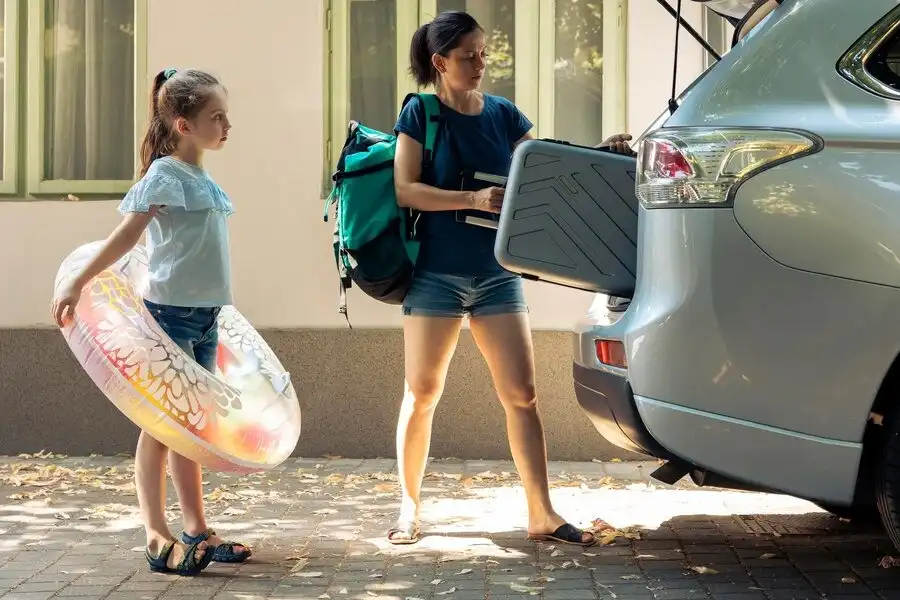The Best Activities to Entertain Kids While Traveling.

Are you gearing up for a family adventure on the road and seeking ingenious methods to Keep Kids Entertained While Traveling? As you prepare for your travels, ensuring that the kids remain captivated can make a world of difference in the overall enjoyment of the trip.
Exploring the updated arsenal of strategies and activities, this guide presents 12 effective ways to maintain a fun-filled atmosphere for children while on the move. From interactive games and technology-based entertainment to creative snack ideas doubling as amusement, this comprehensive update is tailored to make your upcoming travels a delightful experience for the entire family.
“If you are looking for the best hotel and flight deals for your next vacation, then we recommend booking your bundled flight and hotel through hotwire.com.“
Preparation Before the Trip

Before embarking on a journey with kids, effective preparation is key to ensuring a smooth and enjoyable travel experience for both children and adults alike. Adequate planning and packing can significantly contribute to managing unforeseen challenges that may arise during the trip.
Packing Essentials for Entertainment:
When preparing for traveling with kids, it’s essential to include various items that cater to their entertainment needs. Here are some key essentials to consider:
- Travel-friendly Games and Activities: Pack a selection of games and activities suitable for the mode of travel. Consider items like travel-sized board games, cards, or magnetic puzzles that are easy to carry and won’t take up much space.
- Engaging Books and Magazines: Bring age-appropriate books, comics, or magazines that capture their interest. Opt for captivating stories, activity books, or magazines about their hobbies or interests.
- Electronic Devices and Accessories: Depending on your stance on screen time, consider bringing tablets, e-readers, or handheld gaming devices loaded with educational apps, e-books, or games. Don’t forget chargers, headphones, or power banks to ensure uninterrupted entertainment.
- Comfort Items: For younger children, comfort items like their favorite stuffed toy, blanket, or pillow can provide a sense of security and comfort during travel.
Choosing Appropriate Activities Based on Mode of Travel:
Different modes of travel require different approaches to entertainment:
- Car Travel: Long car journeys necessitate activities that can be done within a confined space. Consider games that involve spotting objects outside the window, creating travel bingo cards, or engaging in storytelling sessions.
- Air Travel: Flights might require quieter activities. Coloring books, simple crafts, or engaging apps/games on a tablet can keep kids entertained during the flight.
- Train/Bus Travel: Similar to car travel, but with potentially more movement, activities like small puzzles, travel-sized board games, or interactive storybooks can be suitable options.
By planning and packing a variety of entertainment options tailored to the mode of travel, parents can significantly minimize boredom and restlessness among children, making the journey a more enjoyable experience for everyone involved.
12. Ways to Entertain Kids on a Road Trip

Interactive Games and Activities
1. Game Ideas (e.g., I Spy, 20 Questions)
- I Spy: A classic game that engages children in observing their surroundings. One player selects an object within sight and says, “I spy with my little eye something that is…” and gives a descriptive clue without revealing the object. Other players take turns guessing the object based on the clues provided.
- 20 Questions: This game involves one person thinking of a particular object or thing while the others take turns asking up to 20 yes-or-no questions to determine what it is. The questions should be strategic to narrow down possibilities, leading to an eventual guess of the chosen item.
These interactive games not only entertain kids but also encourage observational skills, critical thinking, and creativity. They are simple yet effective in keeping children engaged and entertained during long road trips.
2. Printable Activities
Printable activities are an excellent way to keep children engaged and entertained during a road trip. These activities are convenient, versatile, and can be easily accessed and carried. They offer a wide range of options to cater to different age groups and interests, making them an ideal choice for family travel.
Variety of Printable Options:
Printable activities come in various forms, providing diverse entertainment possibilities for kids during the journey:
- Coloring Pages: Coloring pages featuring different themes such as animals, nature, characters, or vehicles are widely available online. Kids can bring these to life using crayons, colored pencils, or markers, expressing their creativity while staying occupied.
- Puzzles and Brainteasers: Printable puzzles like crosswords, word searches, mazes, and Sudoku are not only enjoyable but also stimulate cognitive abilities. These puzzles can be adjusted according to different skill levels, ensuring entertainment for kids of varying ages.
- Activity Sheets and Games: Printable activity sheets often include connect-the-dots, spot-the-difference, tic-tac-toe, and other games designed for on-the-go fun. These activities encourage problem-solving, attention to detail, and strategic thinking.
Easy Access and Convenience:
The accessibility of printable activities is one of their key advantages:
- Online Resources: Numerous websites offer free or inexpensive printable activity packs specifically designed for travel. These resources can be downloaded and printed before the trip or accessed online during the journey, ensuring a steady supply of entertainment.
- Customization and Personalization: Parents can tailor printable activities based on their children’s preferences, selecting themes or characters that resonate with them. This customization enhances engagement and enjoyment during the activity.
Benefits of Printable Activities:
Printable activities offer several benefits that contribute to the overall travel experience:
- Portability and Space Efficiency: Unlike bulkier toys or games, printable activities are lightweight and space-efficient. They can be neatly organized in a folder or clipped together, taking up minimal space in a travel bag or backpack.
- Educational Value: Many printable activities are designed with educational elements, fostering learning opportunities even during leisure time. They promote skills such as fine motor control, vocabulary development, problem-solving, and critical thinking.
- Engagement and Distraction: These activities serve as effective distractions, especially during long stretches of travel. They help reduce restlessness and boredom, keeping children engaged and content throughout the journey.
Introducing printable activities into the travel itinerary ensures that kids have a plethora of engaging options at their fingertips, making the road trip not only entertaining but also an opportunity for learning and creative expression.
3. DIY travel kits

Preparing do-it-yourself (DIY) travel kits for kids before embarking on a road trip can be an ingenious way to ensure they stay engaged and entertained throughout the journey. These kits are personalized, customizable, and tailored to suit the interests and preferences of individual children.
- Components of DIY Travel Kits:
DIY travel kits encompass a range of items and activities to keep kids occupied and entertained:
- Busy Bags: These are small, self-contained kits filled with various activities and games designed to engage children for extended periods. Busy bags can include puzzles, coloring materials, small toys, stickers, and interactive games.
- Sensory Kits: Especially beneficial for younger children, sensory kits consist of tactile items that stimulate the senses. Items such as textured fabrics, squishy toys, playdough, or sensory bottles filled with colorful liquids and objects can captivate and entertain.
- Customized Activity Packs: These packs are tailored to a child’s specific interests. For instance, a nature-themed kit might include a magnifying glass, a small journal for observations, and nature-themed activity sheets.
- Advantages of DIY Travel Kits:
Creating personalized travel kits offers numerous advantages:
- Entertainment and Engagement: DIY kits are curated with activities and items that appeal to a child’s preferences, ensuring sustained engagement and entertainment during the journey.
- Reduction of Boredom: By providing a variety of stimulating activities, these kits effectively minimize boredom and restlessness, making the travel experience more enjoyable for both children and adults.
- Organization and Accessibility: These kits are organized into compact containers or bags, making it easy for kids to access their entertainment options without creating a mess or disrupting the travel environment.
- Flexibility and Customization: Parents have the flexibility to design kits according to the age, interests, and preferences of their children. They can include items that align with each child’s unique tastes, ensuring maximum enjoyment.
- Creating DIY Travel Kits:
To create an effective DIY travel kit:
- Select Appropriate Items: Choose items that are compact, mess-free, and suitable for travel. Consider the age, interests, and attention span of the child when selecting activities.
- Packaging and Organization: Use containers, bags, or pouches to organize items neatly. Label or segregate different activities for easy identification and access.
- Consider Multi-Purpose Items: Opt for items that serve multiple purposes or can be used in various activities to maximize space and entertainment value.
DIY travel kits are not only practical but also a thoughtful way to ensure that children have an assortment of engaging and age-appropriate activities to enjoy during the road trip. These kits foster creativity, engagement, and entertainment, contributing significantly to a smoother and more enjoyable travel experience for everyone involved.
Technology-Based Entertainment
4. Recommended apps or games for different age groups
Advancements in technology offer a plethora of apps and games catering to different age brackets, making them an engaging and convenient entertainment option during road trips.
Preschool Age (3-5 years):
- Sago Mini World: This app offers a collection of colorful and interactive games designed specifically for preschoolers. It encourages creativity, problem-solving, and exploration through various characters and activities.
- Endless Alphabet: A fun and educational app that introduces children to letters, words, and vocabulary through delightful animations and interactive puzzles.
Elementary Age (6-10 years):
- Minecraft: Known for its creative freedom and open-world gameplay, Minecraft allows kids to build, explore, and engage in imaginative adventures. It promotes creativity, problem-solving, and teamwork.
- Khan Academy Kids: An educational app covering various subjects such as math, reading, and social-emotional learning through interactive activities and games tailored for elementary-level understanding.
Tween/Teen Age (11-14 years):
- Among Us: A popular multiplayer game involving teamwork and deduction. Players work together to complete tasks on a spaceship while trying to identify impostors among them, fostering critical thinking and social interaction.
- Heads Up!: An interactive and entertaining game where players guess words based on clues provided by their teammates. It’s a great way to encourage communication and quick thinking.
General Recommendations for All Ages:
- Audible: An audiobook app with a vast collection of titles suitable for various age groups. It’s an excellent choice for listening to stories or educational content during the trip.
- PBS Kids Games: Offers a wide array of educational games featuring popular characters from PBS shows. It covers different subjects and skills while keeping kids entertained.
When choosing apps or games for children during a road trip, it’s essential to consider factors like educational value, entertainment, and age-appropriateness. Additionally, ensuring that content aligns with personal values and screen-time guidelines is crucial.
Also, Read– Tips for Planning Your Multigenerational Family Trip!
5. Educational and fun podcasts or audiobooks
Podcasts and audiobooks are excellent choices for entertaining kids during a road trip while simultaneously providing educational content and fostering their imagination.
Podcasts for Kids:
- Wow in the World: This science-themed podcast explores intriguing topics in a fun and engaging manner, making complex scientific concepts accessible and entertaining for young listeners.
- Story Pirates: A podcast that features imaginative stories written by children, adapted into hilarious skits and musical adventures. It encourages creativity and storytelling while offering laughter-filled entertainment.
Audiobooks for Kids:
- Harry Potter series by J.K. Rowling (Narrated by Jim Dale): A captivating series that transports listeners to a magical world filled with adventure, friendship, and life lessons. Jim Dale’s narration brings the characters and story to life.
- The Chronicles of Narnia by C.S. Lewis (Narrated by various artists): This classic fantasy series takes listeners on thrilling journeys through the land of Narnia, filled with talking animals, mythical creatures, and timeless adventures.
Educational Audiobooks:
- National Geographic Kids Audiobooks: These audiobooks cover various topics, from animals and nature to space exploration, providing educational content in an engaging format suitable for young listeners.
- Biography Audiobooks for Kids: Inspirational biographies of historical figures or modern-day influencers can captivate children’s interest while imparting valuable life lessons and historical knowledge.
When selecting podcasts or audiobooks for kids during a road trip, consider their interests, age appropriateness, and the duration of the content. Engaging storytelling, fascinating facts, and interactive elements can make the journey more enjoyable and enriching.
6. Managing screen time effectively
Set Time Limits and Breaks:
- Establish Screen Time Guidelines: Determine specific time slots or durations for screen use during the journey. For instance, allocate an hour for apps or games, followed by a break for other activities.
- Frequent Breaks: Encourage breaks between screen sessions. Use these breaks for other activities like engaging in conversations, playing non-screen games, or observing the surroundings.
Variety of Activities:
- Rotate Entertainment Options: Offer a mix of screen-based activities (apps, movies, or games) and non-screen activities (books, puzzles, or interactive games) throughout the journey.
- Engage in Interactive Play: Encourage activities that involve interaction with family members, such as storytelling, car games, or discussing points of interest along the journey.
Parental Involvement and Monitoring:
- Guided Screen Time: Engage with children during screen time, especially for educational apps or audiobooks, to discuss content and reinforce learning.
- Monitor Content: Ensure that the content being accessed is age-appropriate and aligns with family values. Use parental controls or restricted modes available in apps or devices.
Encourage Alternative Entertainment:
- Provide Entertainment Options: Offer a variety of non-screen entertainment choices, such as activity books, travel games, or DIY kits, to diversify the experience and reduce reliance on screens.
- Involve in Road Trip Planning: Engage children in planning aspects of the road trip, like choosing places to visit or preparing for stops, fostering their excitement and involvement in the journey.
Lead by Example:
- Limit Adult Screen Time: Demonstrate healthy screen time habits by limiting your own use of screens during the trip. Engage in activities that involve interaction and participation with your kids.
- Encourage Offline Interactions: Initiate conversations, storytelling, or games that don’t involve screens to model a balanced approach to entertainment.
Communication and Flexibility:
- Open Communication: Discuss the importance of balance and the reasons behind managing screen time effectively with children. Encourage their understanding and participation in the process.
- Flexibility in Rules: Be open to occasional flexibility in rules, especially during lengthy journeys or exceptional circumstances, while still adhering to the overarching guidelines.
Effectively managing screen time during road trips involves finding a balance between screen-based entertainment and other engaging activities. By implementing these strategies, parents can ensure a well-rounded and enjoyable travel experience while minimizing overreliance on screens and promoting diverse forms of entertainment and interaction among children.
Snacks and Mealtime Entertainment
7. Creative snack ideas that double as entertainment
Build-Your-Own Snack Kits:
- DIY Trail Mix: Provide various nuts, dried fruits, pretzels, and chocolate chips in separate containers, allowing kids to mix and create their personalized trail mix. This activity encourages creativity and offers a healthy snack option.
- Fruit Skewers: Prepare skewers with colorful fruits like berries, melon, and grapes. Kids can create their own combinations, making it a fun and interactive snack experience.
Edible Art and Creations:
- Vegetable and Cheese Shapes: Use cookie cutters to create fun shapes from slices of cheese or vegetables like cucumbers and carrots. Kids can assemble these into playful arrangements or use them to create faces or patterns.
- Decorate-Your-Own Snacks: Offer plain cookies, cupcakes, or crackers with frosting, edible markers, or colorful toppings like sprinkles or fruit slices for kids to decorate and personalize their snacks.
Interactive Snack Games:
- Food-Based Puzzles or Games: Create puzzles using crackers or fruit slices that need to be arranged in a particular order or sequence before eating, turning snack time into a small challenge.
- Snack Tasting Games: Blindfolded taste tests with different flavors of popcorn, crackers, or fruits can be a playful way to engage taste buds and add an element of surprise.
Storytelling with Snacks:
- Snack-Story Associations: Associate snacks with parts of a story or adventure. For instance, each snack item represents a character or event in a story, encouraging kids to munch along as the tale unfolds during the journey.
- Create Snack Characters: Use snack items like fruits, veggies, and spreads to construct characters or scenes, fostering imagination and storytelling through edible art.
Educational Snacking:
- Alphabet or Number Snacks: Use snacks like sliced fruits, crackers, or cheese to form letters or numbers. This doubles as a learning activity while snacking, aiding in early education.
- Geography with Snacks: Introduce snacks from different regions or countries, allowing kids to explore new tastes while learning about diverse cultures and geography.
Integrating snack time with entertainment not only keeps children engaged but also encourages creativity, imagination, and learning. These creative snack ideas not only satiate hunger but also provide a platform for interactive fun, fostering an enjoyable and engaging road trip experience for kids.
8. Food-related games or challenges
Guess the Flavor:
- Blindfold Taste Test: Blindfold one participant and have them taste various snacks or condiments, trying to guess the flavor. This game not only adds an element of surprise but also engages taste buds and sensory skills.
- Mystery Food Challenge: Wrap different foods in foil or containers, and have kids guess the contents by touch, smell, or taste. It’s a playful way to introduce new foods and encourage exploration.
Speedy Snack Challenges:
- Build a Tower: Provide snack items like crackers, marshmallows, or cheese cubes, and challenge kids to build the tallest tower within a set time. This activity promotes creativity and fine motor skills.
- Fastest Eater Competition: Set up a healthy snack, such as apple slices or grapes, and challenge participants to eat them using chopsticks or a specific utensil within a time limit. It’s a fun and competitive way to enjoy snacks.
Trivia or Quiz Games:
- Food Trivia: Prepare a list of food-related trivia questions or facts and turn snack time into a quiz session. Engage kids with interesting information about different foods or cuisines.
- Name that Food: Describe a specific food item without revealing its name, and let participants guess what it is. This game encourages descriptive skills and deduction.
Food Art and Creativity:
- Edible Sculptures: Provide snacks like fruits, vegetables, or modeling candy and challenge kids to create sculptures or artwork using only edible items.
- Food Mandala Creation: Arrange small snack items like nuts, seeds, or dried fruits in a circular pattern on a plate, fostering creativity and a calming activity during the journey.
Imaginative Role-Play with Food:
- Restaurant Pretend Play: Assign roles such as chef, waiter, or customer and allow kids to create a mini-restaurant experience using snacks as menu items. This game encourages imagination and social interaction.
- Food Storytelling: Use snack items as props while telling a collaborative story, where each snack represents a character or object in the narrative, making snack time an interactive storytelling session.
These food-related games and challenges not only add a layer of entertainment but also promote creativity, social interaction, and exploration of different tastes and textures. They transform mealtime into a fun and engaging activity during the road trip, fostering memorable experiences for kids and family members alike.
Creative Storytelling and Imagination
9. Storytelling prompts or games
Round-Robin Storytelling:
- Story Circle: Begin a collaborative storytelling game where each participant contributes a sentence or part of the story in turns. This activity encourages creativity and collaboration among storytellers.
- Add-a-Sentence Story: Start a story with a single sentence, and each participant adds a sentence, building the narrative together. This game leads to unexpected twists and turns in the storyline.
Picture or Object Prompts:
- Story Starter Pictures: Show children a picture from a book, magazine, or printed images and prompt them to create a story based on what they see. Encourage imagination and descriptive storytelling.
- Object-Based Storytelling: Provide random objects from the travel bag or surroundings and ask kids to incorporate these objects into a story, improvising and weaving them into their narratives.
Story Dice or Cards:
- Story Dice Game: Use story dice with images or words and roll them. Encourage kids to incorporate the images or words rolled into their ongoing story or create a new story based on the results.
- Story Cards with Prompts: Create cards with story prompts like characters, settings, or events. Children pick cards and use the prompts to start or develop their stories, enhancing creativity.
Theme or Genre-based Stories:
- Fantasy World Creation: Encourage children to create a fantasy world with unique characters, landscapes, and adventures. This open-ended activity sparks imaginative storytelling.
- Mystery or Adventure Stories: Prompt kids to tell stories involving mystery-solving or thrilling adventures, allowing them to explore suspenseful or action-packed narratives.
Storytelling through Role-Play:
- Character Role-Play: Assign characters to each participant and let them narrate the story from their character’s perspective, encouraging empathy and diverse storytelling.
- Improvisational Storytelling: Give children a basic plot outline or scenario, and let them spontaneously create and act out a story, boosting spontaneity and imaginative thinking.
Nature or Surrounding-based Stories:
- Scenery Inspiration: Use the passing scenery or landmarks as inspiration for storytelling. Prompt kids to create stories based on what they observe outside the vehicle window.
- Travel Journal Stories: Encourage kids to maintain a travel journal and turn their experiences and observations into imaginative stories, blending reality with imagination.
These storytelling prompts and games foster creativity, communication skills, and imaginative thinking among children. They transform a road trip into an opportunity for collaborative storytelling and imaginative exploration, making the journey more engaging and memorable.
10. Role-playing or creating imaginative scenarios
Character-Based Role-Playing:
- Superhero Adventures: Encourage kids to invent their superhero personas, complete with superpowers and heroic missions. They can act out scenarios, adding excitement to the journey.
- Fairy Tale Retelling: Assign roles from classic fairy tales or invent new ones. Kids can act out these stories or create their versions, fostering creativity and improvisation.
Imaginary Scenarios:
- Time Travel Adventure: Prompt kids to imagine they can time-travel. Ask them to describe where they would go, who they would meet, and what adventures they would have in different eras.
- Space Exploration: Encourage children to imagine embarking on a space adventure, visiting planets, encountering aliens, and exploring the mysteries of the cosmos.
Inventive Story Building:
- Create Your World: Have kids invent their imaginary worlds, complete with unique creatures, landscapes, and rules. This activity nurtures creative thinking and world-building skills.
- Mystery Solving: Present a mystery or puzzle scenario and encourage kids to collaborate, brainstorming solutions and working as a team to unravel the mystery during the trip.
Occupation-Based Role-Play:
- Pretend Professions: Assign pretend professions or roles like doctors, astronauts, detectives, or chefs. Kids can imagine scenarios related to these roles, adding depth to their imaginative play.
- Animal Adventures: Let kids pretend to be animals, creating stories and scenarios from an animal’s perspective. This fosters empathy and encourages exploration of different viewpoints.
Interactive Story Creation:
- Group Storytelling: Prompt children to create a story collaboratively, taking turns adding parts of the narrative. This exercise hones storytelling skills and encourages teamwork.
- Visual Story Mapping: Use a whiteboard or paper to visually map out a story. Kids can draw scenes or characters, connecting them to build a storyline together.
Historical or Cultural Exploration:
- Time Period Exploration: Encourage kids to imagine living in different historical periods like ancient civilizations or the future, exploring how life might be different.
- Cultural Celebration: Create scenarios involving cultural celebrations or traditions from various countries, promoting cultural understanding and appreciation.
Role-playing and creating imaginative scenarios during a road trip not only entertain children but also stimulate their creativity, critical thinking, and social skills.
Engaging with Surroundings
11. Spotting and discussing landmarks or unique sights
Scenic Spot Identification:
- Landmark Spotting: Encourage kids to spot famous landmarks, unique buildings, or natural features along the route. Create a game where they identify and mark off landmarks on a map or checklist.
- Geographical Features: Prompt kids to observe and discuss geographical features like mountains, rivers, lakes, or forests. Encourage them to appreciate the beauty and uniqueness of nature.
Historical or Architectural Discussions:
- Historical Significance: When passing historical sites or monuments, share intriguing facts or stories about their significance. Engage kids in discussions about the history behind these landmarks.
- Architectural Wonders: Point out distinct architectural styles or fascinating buildings. Discuss their designs, purposes, and any interesting facts related to their construction.
Local Culture and Traditions:
- Cultural Observations: Encourage kids to observe and discuss differences in local customs, traditions, or even languages in different areas. Discussing diversity fosters cultural understanding.
- Local Wildlife or Flora: If passing through diverse landscapes, prompt discussions about local wildlife or plant life. Encourage curiosity about unique species they might encounter.
Interactive Learning:
- Trivia and Fun Facts: Create a trivia game based on the sights or landmarks they observe. Prepare interesting facts or quiz questions related to the places they see.
- Storytelling Inspired by Sights: Prompt children to create imaginative stories based on the landmarks or sights they spot, fostering creativity and imaginative thinking.
Travel Journaling or Sketching:
- Journaling Experience: Encourage kids to keep a travel journal or sketchbook, documenting the sights they see or drawing scenes that capture their imagination.
- Photo or Sketch Stops: Plan stops at particularly scenic locations or landmarks, allowing children to take photos or make sketches to preserve memories and experiences.
Interactive Discussions:
- Encourage Curiosity: Invite kids to ask questions about the sights they observe. Engage in conversations to answer their queries or discuss their interpretations and thoughts.
- Create Memories Together: Use landmark discussions as bonding opportunities. Share personal stories or memories related to similar places to make the experience more personal and memorable.
Engaging with surroundings by spotting and discussing landmarks or unique sights not only entertains kids but also nurtures their curiosity, cultural awareness, and appreciation for the world around them.
12. Travel journals or drawing/scrapbooking experiences
Personalized Travel Journals:
- Journaling Adventures: Provide each child with a travel journal or notebook to document their experiences, feelings, and observations during the road trip. Encourage them to write about the places visited, new things learned, and memorable moments.
- Daily Diary Entries: Prompt kids to write daily entries, sharing their thoughts, favorite moments, or even challenges faced during the journey. This activity encourages reflection and expression.
Sketching or Drawing Activities:
- Scenic Sketching: Encourage kids to capture landscapes, landmarks, or interesting sights through sketches or drawings. Provide sketchbooks and art supplies for them to unleash their creativity.
- Travel Doodles: Encourage casual doodling or sketching during downtime, allowing kids to draw whatever inspires them—be it funny characters, imaginary scenes, or the passing scenery.
Scrapbooking the Adventure:
- Keepsake Collages: Provide materials like glue, scissors, colored paper, and printed photos to create scrapbook pages capturing the journey’s highlights. Encourage them to add tickets, brochures, or other memorabilia.
- Themed Scrapbook Pages: Create themed pages for specific destinations or activities, allowing kids to design layouts and add written descriptions, creating a visual and written account of the trip.
Interactive Mapping and Planning:
- Route Mapping: Provide a large map and markers for kids to mark the route taken, major stops, and destinations visited. This visual representation aids in geographical learning.
- Trip Planning Pages: Encourage children to plan future stops or activities on the journey, drawing or writing about places they’d like to explore, creating a sense of anticipation.
Family Collaborative Projects:
- Collaborative Journaling: Engage in group activities where family members contribute to a shared journal or scrapbook, each adding their perspectives, drawings, or written accounts.
- Memory Sharing: Use journaling or scrapbooking sessions as an opportunity for family members to share stories or experiences related to past trips, fostering connection and bonding.
Reflections and Reviews:
- Review and Reflection: Encourage kids to review their journal or scrapbook at the end of the trip. Ask them to reflect on their favorite moments, lessons learned, and what they’d like to remember most.
- Sharing Stories: Arrange a storytelling session where kids share excerpts from their journals or explain the significance behind their drawings or scrapbook entries, encouraging communication and expression.
Engaging in travel journals, drawing, or scrapbooking experiences not only fosters creativity but also encourages reflection and documentation of the journey. These activities serve as treasured keepsakes, capturing the essence of the road trip and creating lasting memories for children to cherish and revisit in the future.
Tips for a Smooth Travel Experience
Planning and Preparation:
- Route Planning: Plan the route in advance, considering road conditions, rest stops, and attractions along the way. Use navigation apps or GPS devices for real-time updates.
- Vehicle Check: Ensure the vehicle is in good condition before departure. Check tire pressure, fluids, brakes, and have a roadside emergency kit handy.
- Packing Essentials: Pack essentials such as snacks, water, first aid kit, entertainment for kids, chargers, maps, and any necessary documents well in advance.
Comfort and Safety:
- Comfortable Clothing: Dress in comfortable clothes suitable for long hours of sitting. Layering is helpful for varying temperatures during the trip.
- Frequent Breaks: Schedule regular breaks for stretching, restroom stops, and to avoid fatigue. Take turns driving to stay fresh and alert.
- Safety Measures: Ensure everyone wears seat belts and adheres to traffic rules. Keep emergency contacts handy and be prepared for unexpected situations.
Entertainment and Engagement:
- Variety of Activities: Prepare a variety of entertainment options for kids, such as games, audiobooks, coloring books, or interactive activities to keep them engaged.
- Engage with Surroundings: Encourage discussions about landmarks, nature, or local culture to make the journey educational and interactive.
Healthy Practices:
- Hydration and Snacks: Stay hydrated by drinking water regularly and have healthy snacks available. Avoid excessive caffeine or sugary drinks.
- Rest and Sleep: Ensure adequate rest before the trip and take breaks for sufficient rest during the journey to prevent driver fatigue.
Flexibility and Patience:
- Flexibility in Plans: Be open to unforeseen changes in plans due to traffic, weather, or unexpected circumstances. Have alternate routes or activities ready.
- Patience is Key: Maintain a positive attitude and practice patience, especially during unexpected delays or challenging situations.
Communication and Fun:
- Family Bonding: Use the time together for meaningful conversations, storytelling, and creating shared experiences that strengthen family bonds.
- Capture Memories: Take photos or videos to capture memorable moments during the trip. Encourage kids to document their experiences in journals or drawings.
By considering these tips, you can better prepare for a road trip, ensuring a smoother, safer, and more enjoyable travel experience for everyone involved.
How much did you like Our detailed 12-Ways to Keep Kids Entertained While Traveling: (2024 Updated)? Review Also, please share these Blogs with your friends on social media.
Recommended
Conclusion
Embarking on a road trip with your family can be an exciting and rewarding experience filled with adventure, learning, and bonding moments. Throughout this journey, ample planning, thoughtful preparation, and engaging activities play pivotal roles in ensuring a smooth and enjoyable travel experience for everyone involved.
From the initial preparation, including creating entertaining DIY travel kits, exploring technology-based entertainment, and organizing engaging snack and mealtime activities, to fostering creativity through storytelling, imaginative play, and interactive discussions about landmarks and surroundings, every aspect contributes to making the journey memorable.
Encouraging children to participate in travel journals, drawing, and scrapbooking experiences not only captures the essence of the trip but also promotes creativity and self-expression. Prioritizing comfort, safety, and healthy practices along the way enhances the overall well-being of travelers.

Meet David Hoper, a passionate travel Blog writer with 7+ years of experience in travel content. Through his exemplary storytelling and engaging narratives, he shares his experiences and brings destinations to life. With a keen eye for detail and a love for exploration, he has cultivated a diverse portfolio of travel blogs that inspire and inform readers worldwide.








